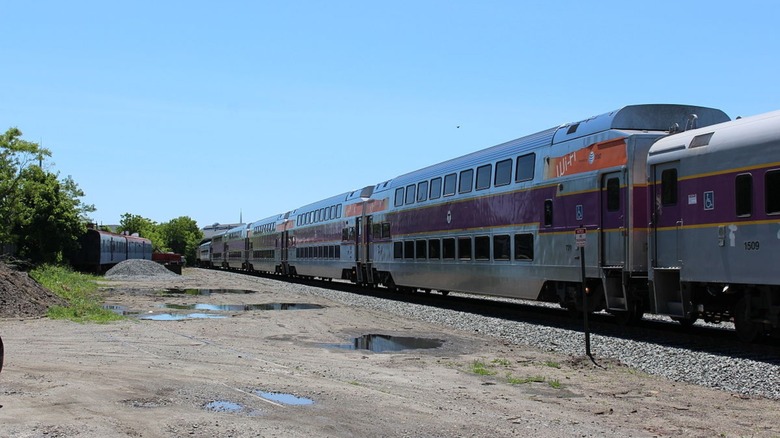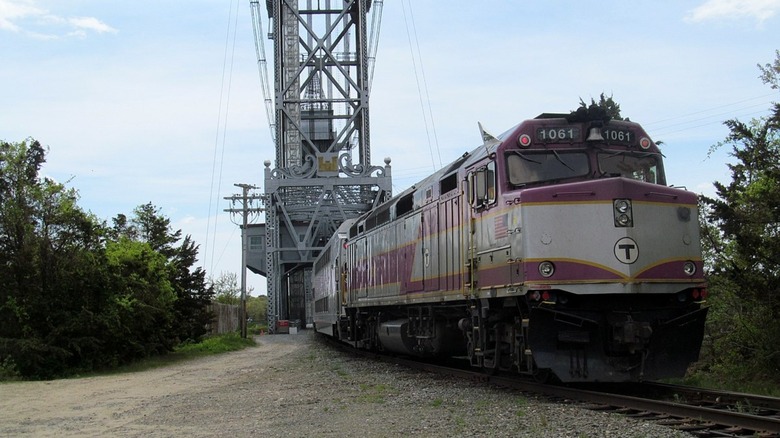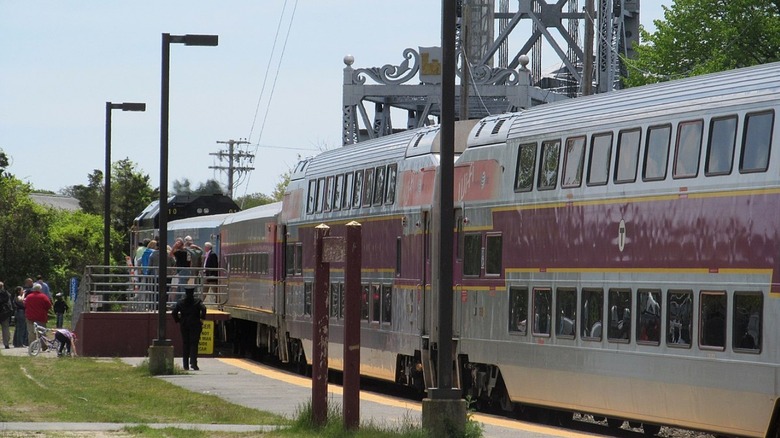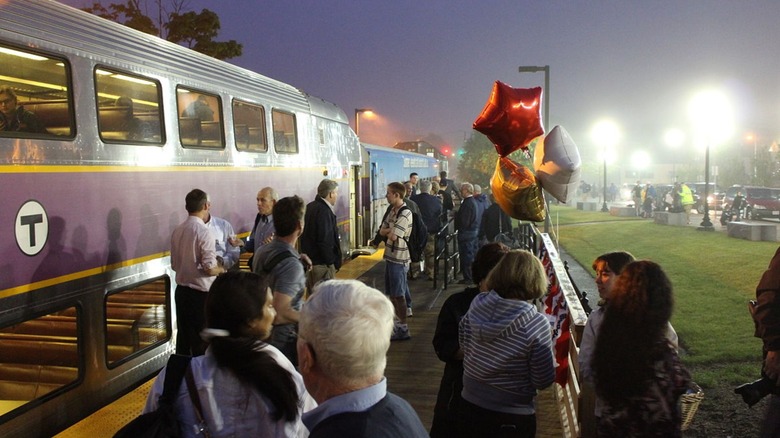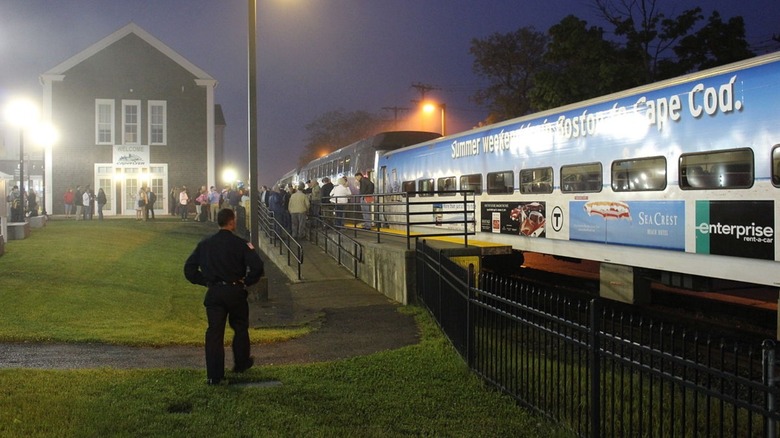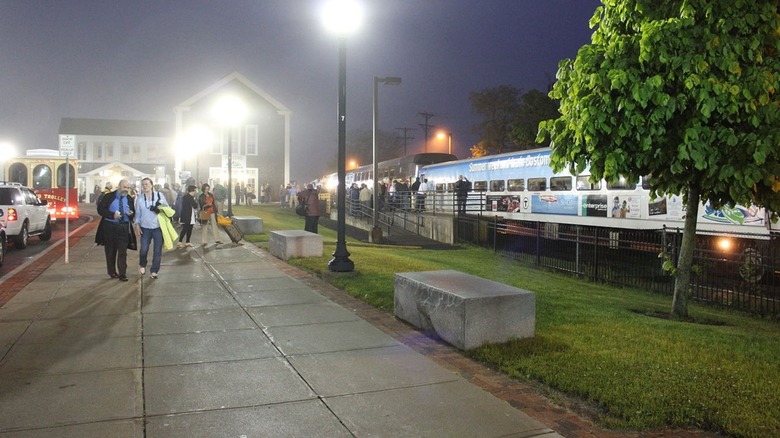Everything To Know About The Massachusetts CapeFLYER Train
We all have our favorite modes of transportation. Petrolheads often won't listen to criticism against the car, but they do lack the sheer directness of train travel. The latter has more in common with airplanes, in a way: the scale of the vehicle, the almost-as-the-crow-flies route, the convenience of sitting back and even having a meal as you speed towards your destination ... there are certainly pros to train travel.
Of course, the price and the length of your journey riding the rails, as well as the overall journey, will differ a lot depending on where you're going and which particular train you're on. If you're in Massachusetts, you might even get the distinct pleasure of a ride on the illustrious CapeFLYER.
The CapeFLYER may not be the most luxurious train in the world, and certainly isn't as fast as you may expect an all-caps FLYER to be. What it is, though, is a unique and important part of Massachusetts history (and the broader history of passenger trains). In honor of this venerable vehicle, this one-stop rundown will tell you everything you need to know about it, from the trains that were in place before it and when it was established to the route it takes and the price of a ride on it. Settle in and enjoy, Massachusetts railbuffs, as we admire one of many transportation icons the world has to offer.
[Featured image by Kevin Rutherford via Wikimedia Commons | Resized and cropped | CC By-SA 4.0]
The CapeFLYER's history
The CapeFLYER started service in April 2013. The Bay State's own Senator Elizabeth Harris proclaimed (according to the Massachusetts Bay Transportation Authority), "Bringing back seasonal rail service from Boston to Hyannis will help make it easier for visitors to travel to the Cape and support Massachusetts' tourism industry." This is a reference to the fact that services had run in the area previously over a century and a half ago.
The Cape Cod Commission reports that the Cape Cod Branch Railroad built the Cape's first railway track in 1848. Six years later, the Cape Cod Railroad extended the tracks "as far as Hyannis and Yarmouthport." Tracks and routes would change over time, and it wasn't until decades later that the authorities decided to try to cut the burgeoning issue of increasingly busy roads by providing a route that could connect the Cape more broadly.
The FLYER's service was originally expected to start a year earlier, in 2012 (the venerable train is far from the oldest locomotives ever), but budget concerns caused delays. Jonathan Davies of the MBTA put it at the time, per WGBH, "We have the reality of having a budget deficit, and we need to concentrate on what we're providing today." The next year, the FLYER's debut season proved a success, as we'll see, replacing the Cape Codder, another seasonal passenger train servicing Cape Cod (beginning in 1986).
[Featured image by Pi.1415926535 via Wikimedia Commons | Resized and cropped | CC By 3.0]
The route followed by today's CapeFLYER
Being introduced in 2013, the CapeFLYER is a veritable whippersnapper compared to some of its predecessors. Over the long history of Cape Cod rail, the route changed and expanded, ultimately arriving at the route the venerable FLYER follows today.
The FLYER's route begins at South Station, before passing through these areas: Braintree, Middlesborough/Lakeville, Wareham Village, Buzzards Bay, Bourne, and Hyannis. There's also the Brockton station, after Braintree. The journey, then, allows travelers to take in some of the best things that the picturesque Cape Cod has to offer. Are you looking to visit the lively hub that is the Cape Cod canal? Buzzards Bay is the perfect stop. The land of wonderful beaches, bridges, and whales, millions of people visit the picturesque Cape every year, and the CapeFLYER is on hand to help them make their way.
Needless to say, though, a train can't take customers all the way by itself. There's little that tourists enjoy more than convenient travel links between the station they've arrived in and the attraction/accommodation they're on their way to, and the FLYER is well-equipped to help there too: From ferries to cars to rent, you'll have easy access to the transportation you need for the next leg of your journey on disembarking the train.
Wherever you join or exit the FLYER on its route, you're advised to prepare for minor crowds.
[Featured image by Pi.1415926535 via Wikimedia Commons | Resized and cropped | CC By 3.0]
How many passengers does the CapeFLYER service?
The thing about popular tourist destinations, of course, is that they're often packed. If you're planning a summer trip to Cape Cod, then, you'll surely want to know exactly how many people use the CapeFLYER.
Over a history of more than a decade, these numbers have been rather changeable. 2013, its first year of operation, was quite a success. An October 2013 Press Release from Deval Patrick, Massachusetts Governor, revealed that "ridership on the Cape Flyer through Columbus Day weekend was 16,586. Fare revenue from the line totaled more than $290,000." The popularity of the line in more recent years has been tempered by the menace of COVID-19, and there are no prizes for guessing that 2020 marked a major low for usage of the FLYER: only 2,453 people rode those rails that year. The pandemic's long shadow then retreated and the train's usage increased once more: In 2021, it had a total of 9,473 passengers, increasing again to 12,825 in 2023.
These figures may seem relatively modest compared to some extreme cases (Japan's Shinjuku Station is the busiest railway station on the planet, Guinness World Records reports, with a throughput of 2,704,703 passengers every day), but the crucial thing to remember is that the FLYER is strictly seasonal. Its route is available from the weekends of Memorial Day to Labor Day (plus later on Fridays).
[Featured image by Kevin Rutherford via Wikimedia Commons | Resized and cropped | CC By-SA 4.0]
The price of a trip on the CapeFLYER train
By now, rail enthusiasts planning trips in the Cape Cod area are probably considering adding a trip on the FLYER to their (seasonal) itinerary. As with any trip, budgeting is a sometimes-tedious yet always crucial factor, so how much might you have to pay for a ride on the FLYER?
The service's website states that prices begin at $5, for a one-way trip to the end of the line, Hyannis, from stops between Middleborough and Bourne. On the other end of the scale, $60 is the price for a return ticket covering the whole route ($37 if you're only traveling one way).
These are the base prices, and there are certain types of concessions that you may be able to apply to your journey on top of this. These include the SummerRide season pass for group purchases, which offers two free tickets when eight are brought together. Children of ten or younger, meanwhile, ride free with a paying parent or carer, while those with valid Transportation Access Pass Charliecards or Senior Charliecards can enjoy a hefty discount.
Cape Cod is a popular destination – Cape Cod National Seashore attracted four million tourists in 2022, according to the National Park Service – and particularly so with families. The versatility and affordability of the FLYER plays into this, allowing travelers of all ages more freedom to travel the Cape.
[Featured image by Kevin Rutherford via Wikimedia Commons | Resized and cropped | CC By-SA 4.0]
How Long Is The Journey On The CapeFLYER?
With the FLYER also welcoming pets aboard and highlighting accessibility, it's a family-friendly ride. Despite this, it's vital to note that younger travelers' patience in particular can only be pushed so far. The next crucial aspect of the CapeFLYER to consider, then, is how long the journey is.
As a train designed for travelers and tourists, comfort is emphasized, with its large seats, food service, and dedicated first-class car. The latter was introduced in May 2024, adding a touch of luxury. The Cape Cod Regional Transit Authority boasted at the time that "large leather reclining seats with footrests and tray tables" are the primary amenities on board. What customers will need, then, is the time to enjoy them. First-class prices are $30 in June or $60 in July for a return trip on the full service.
The FLYER can travel only at 30mph, due to limitations on passenger trains in the area. It's probably unsurprising that the full route will take approximately 2.5 hours. It's quite a stretch for a journey of around 80 miles (and far from the fastest passenger trains on the planet), but those who have spent journeys harried and dashing to connections will surely see the value of this unhurried way to see and access the Cape. This latest iteration of passenger service there is developing a legacy of its own.
[Featured image by Kevin Rutherford via Wikimedia Commons | Resized and cropped | CC By-SA 4.0]
